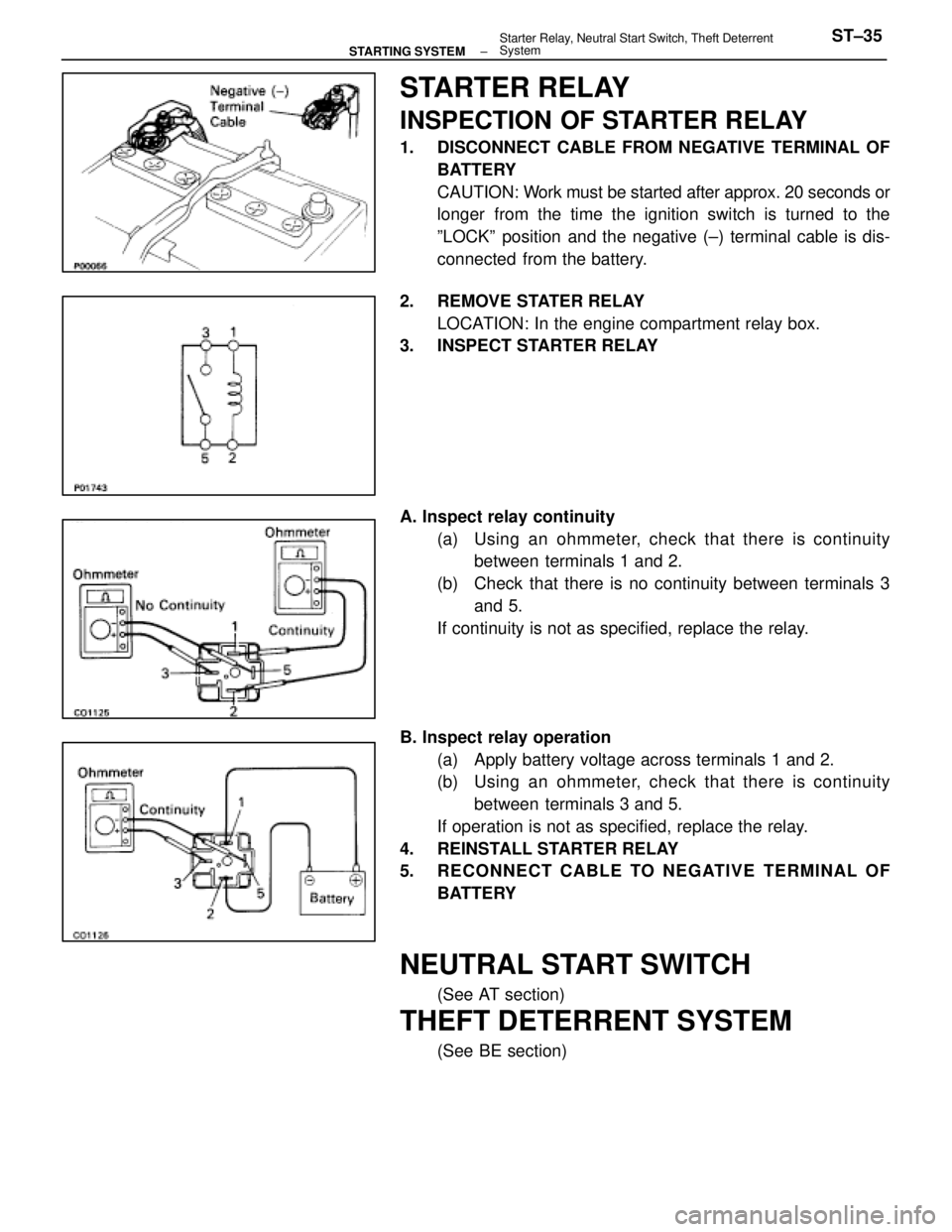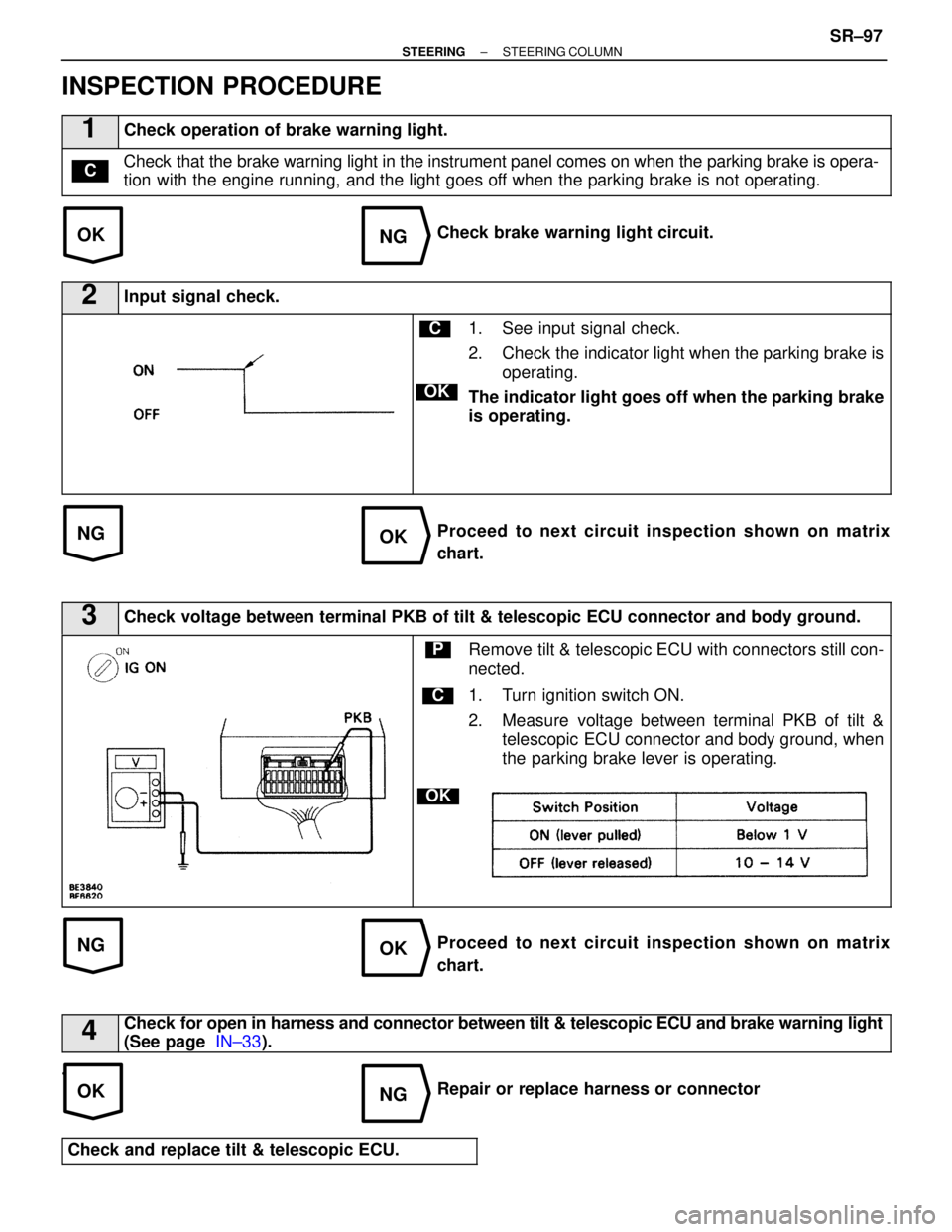Page 2927 of 4087

STARTER RELAY
INSPECTION OF STARTER RELAY
1. DISCONNECT CABLE FROM NEGATIVE TERMINAL OFBATTERY
CAUTION: Work must be started after approx. 20 seconds or
longer from the time the ignition switch is turned to the
ºLOCKº position and the negative (±) terminal cable is dis-
connected from the battery.
2. REMOVE STATER RELAY LOCATION: In the engine compartment relay box.
3. INSPECT STARTER RELAY
A. Inspect relay continuity
(a) Using an ohmmeter, check that there is continuitybetween terminals 1 and 2.
(b) Check that there is no continuity between terminals 3 and 5.
If continuity is not as specified, replace the relay.
B. Inspect relay operation (a) Apply battery voltage across terminals 1 and 2.
(b) Using an ohmmeter, check that there is continuitybetween terminals 3 and 5.
If operation is not as specified, replace the relay.
4. REINSTALL STARTER RELAY
5. RECONNECT CABLE TO NEGATIVE TERMINAL OF BATTERY
NEUTRAL START SWITCH
(See AT section)
THEFT DETERRENT SYSTEM
(See BE section)
±
STARTING SYSTEM Starter Relay, Neutral Start Switch, Theft Deterrent
SystemST±35
WhereEverybodyKnowsYourName
Page 2957 of 4087

OKNG
NGOK
NGOK
OKNG
INSPECTION PROCEDURE
1Check operation of brake warning light.
Check that the brake warning light in the instrument panel comes on when the \
parking brake is opera-
tion with the engine running, and the light goes off when the parking brake is not operating.C
Check brake warning light circuit.
2Input signal check.
C
OK
1. See input signal check.
2. Check the indicator light when the parking brake isoperating.
The indicator light goes off when the parking brake
is operating.
Proceed to next circuit inspection shown on matrix
chart.
3Check voltage between terminal PKB of tilt & telescopic ECU connector and bod\
y ground.
C
OK
PRemove tilt & telescopic ECU with connectors still con-
nected.
1. Turn ignition switch ON.
2. Measure voltage between terminal PKB of tilt & telescopic ECU connector and body ground, when
the parking brake lever is operating.
Proceed to next circuit inspection shown on matrix
chart.
4Check for open in harness and connector between tilt & telescopic ECU and brak\
e warning light
(See page IN±33).
.
Repair or replace harness or connector
Check and replace tilt & telescopic ECU.
±
STEERING STEERING COLUMNSR±97
WhereEverybodyKnowsYourName
Page 2973 of 4087

ON±VEHICLE INSPECTION
CHECK IDLE±UP
SR0FZ±04
1. WARM UP ENGINE
2. TURN AIR CONDITIONER SWITCH OFF
3. CHECK IDLE±UP
(a) Fully turn the steering wheel.
(b) Check that the engine rpm decreases when the air controlvalve hose is pinched.
(c) Check that the engine rpm increases when the air control valve hose is released.
FLUID LEVEL CHECK
SR0G0±03
1. KEEP VEHICLE LEVEL
2. BOOST FLUID TEMPERATUREWith the engine idling at 1,000 rpm or less, turn the steering
wheel from lock to lock several times to boost fluid tempera-
ture.
Fluid temperature:
805C (176 5F)
3. STOP ENGINE
4. CHECK FOR FOAMING OR EMULSIFICATION
HINT: Foaming and emulsification indicate either the exis-
tence of air in the system or that the fluid level is too low.
5. CHECK FLUID LEVEL IN OIL RESERVOIR Check the fluid level and add fluid if necessary.
Fluid:
ATF DEXRON
[ II
HINT: Check that the fluid level is within the HOT LEVEL of
the dipstick of the reservoir cap. If the fluid is cold, check that
it is within the COLD LEVEL of the dipstick.
±
STEERING POWER STEERINGSR±113
WhereEverybodyKnowsYourName
Page 2975 of 4087

POWER STEERING SYSTEM BLEEDING
SR0G2±04
1. CHECK FLUID LEVEL IN OIL RESERVOIRCheck the fluid level and add fluid if necessary.
Fluid:
ATF DEXRON
[ II
HINT: Check that the fluid level is within the HOT LEVEL of
the dipstick of the reservoir cap. If the fluid is cold, check that
it is within the COLD LEVEL of the dipstick.
2. START ENGINE AND TURN STEERING WHEEL FROM LOCK TO LOCK 3 OR 4 TIMES
With the engine speed below 1,000 rpm, turn the steering
wheel to left or right full lock and keep it there for 2±3 se-
conds, then turn the wheel to the opposite full lock and keep
it there for 2±3 seconds.
3. CHECK THAT FLUID IN OIL RESERVOIR IS NOT FOAMY OR CLOUDY AND DOES NOT RISE OVER MAXIMUM
WHEN ENGINE IS STOPPED
Measure the fluid level with the engine running. Stop the en-
gine and measure the fluid level.
Maximum rise:
5 mm (0.20 in.)
If a problem is found, repeat fluid replacement on page
SR±114. Rep air the PS if the problem persists.
OIL PRESSURE CHECK
SR0G3±03
1. CONNECT PRESSURE GAUGE
(a) Using SST, disconnect the pressure line joint.SC 400:
SST 09631±22020
±
STEERING POWER STEERINGSR±115
WhereEverybodyKnowsYourName
Page 2976 of 4087

(b) Connect the gauge side of the pressure gauge to the PSpump side, and the valve side to the gear housing side.
2. BLEED POWER STEERING SYSTEM (See page SR±115)
3. START ENGINE AND RUN IT AT IDLE
4. BOOST FLUID TEMPERATURE With the engine idling at 1,000 rpm or less, turn the steering
wheel from lock to lock several times to boost fluid tempera-
ture.
Fluid temperature: 80 �C (176 �F)
5. CHECK FLUID PRESSURE READING WITH VALVE
CLOSED
Close the pressure gauge valve and observe the reading on
the gauge.
Minimum pressure:
7,355 kPa (75 kgf/cm
2, 1,067 psi)
NOTICE:
w Do not keep the valve closed for more than 10 seconds.
w Do not let the fluid temperature become too high.
If pressure is low, repair or replace the PS vane pump.
6. OPEN VALVE FULLY
7. CHECK AND RECORD PRESSURE READING AT 1,000
RPM
8. CHECK AND RECORD PRESSURE READING AT 3,000 RPM
Check that the pressure difference between the 1,000 rpm
and 3,000 rpm checks is less than 490 kPa (5 kgf/cm
2, 71
psi). If the difference is excessive, repair or replace the flow
control valve of the PS vane pump.
NOTICE: Do not operate the steering wheel.
SR±116±
STEERING POWER STEERING
WhereEverybodyKnowsYourName
Page 2977 of 4087

9. CHECK PRESSURE READING WITH STEERING WHEELTURNED TO FULL LOCK
Be sure the pressure gauge valve is fully opened and the en-
gine idling.
Minimum pressure:
7,355 kPa (75 kgf/cm
2, 1,067 psi)
NOTICE:
w Do not maintain lock position for more than 10 seconds.
w Do not let the fluid temperature become too high.
If pressure is low, the gear housing has an internal leak and
must be repaired or replaced.
10. MEASURE STEERING EFFORT
(a) Center the steering wheel and run the engine at idle.
(b) Using a spring scale, measure the steering effort in both directions.
Maximum steering effort:
40 N (4.1 kgf, 9.0 lbf)
If steering effort is excessive, repair the power steering unit.
HINT: Be sure to consider the tire type, pressure and contact
surface before making your diagnosis.
(c) Disconnect the solenoid connector.
(d) Using a spring scale, measure the steering effort in both directions.
(Reference)
Maximum steering effort:
76 N (7.7 kgf, 17.0 lbf)
If steering effort is not heavier than (b), check solenoid.
HINT: Be sure to consider the tire type, pressure and contact
surface before making your diagnosis.
±
STEERING POWER STEERINGSR±117
WhereEverybodyKnowsYourName
Page 3147 of 4087

1. DISCONNECT NEGATIVE (±) TERMINAL CABLE FROMBATTERY
CAUTION: Work must be started after 90 seconds from
the time the ignition switch is turned to the ªLOCKº posi-
tion and the negative (±) terminal cable is disconnected
from the battery.
(See page RS±2)
2. REMOVE ENGINE UNDER COVER
(See page BO±12)
3. REMOVE FRONT AIRBAG SENSOR
(a) Disconnect the connector.
(b) Remove the bolt, the nut and the sensor.
4. INSTALL FRONT AIRBAG SENSOR
(a) Install the sensor with the arrow on the sensor facing toward the front of the vehicle.
Torque: 25 N Vm (260 kgf Vcm, 19 ft Vlbf)
NOTICE:
w Make sure the sensor is installed to the specified torque.
w If the sensor has been dropped, or there are cracks, dents
or other defects in the case, brackets or c onnector,
replace the sensor is removed, always replace the set bolt
and the nut with new one.
w The sensor set bolt and the nut have been anti±rust
treated. When the sensor is removed, always replace the
set bolt and the nut with new ones.
w After installation, shake the sensor to check that there is
no looseness.
w The front sensor is equipped with an electrical
connection check mechanism. Be sure to lock this
mechanism securely when connecting the connector. If
the connector is not securely locked, a malfunction code
will be detected by the diagnosis system.
w Check that the dimensions of the body where the front
airbag sensor is installed match those in the body
dimension drawings in the BODY section.
(The SRS may malfunction, or may not work, if the
dimensions of the sensor mount is not correct.)
5. INSTALL ENGINE UNDER COVER
6. CONNECT NEGATIVE (±) TERMINAL CABLE TO BATTERY
±
SUPPLEMENTAL RESTRAINT SYSTEM FRONT AIRBAG SENSORRS±43
WhereEverybodyKnowsYourName
Page 3173 of 4087

YESNO
INSPECTION PROCEDURE
1Preparation.
P1. Turn ignition switch LOCK.
2. Disconnect battery negative (±) terminal cable, andwait at least 90 seconds.
3. Connect battery negative (±) terminal cable.
4. Disconnect center airbag sensor assembly con- nector.
5. Turn ignition switch ON. But do not start engine.
6. Measure voltage at IG
2 or ACC on connector wire
harness side of center airbag sensor assembly and
operate electric system (defogger, wiper, headlight,
heater blower, etc.)
Voltage: 6 V ± 11.5 V at IG
2 and ACC.
7. Turn electric system switch OFF.
8. Turn ignition switch LOCK.
9. Disconnect battery negative (±) terminal cable, and wait at least 90 seconds.
10. Remove voltmeter and connect center airbag sen- sor assembly connector.
11. Connect battery negative (±) terminal cable.
2Does SRS warning light turn off after approx. 10 seconds?
C
PTurn ignition switch ACC or ON and wait at least 20 sec-
onds.
Clear malfunction code. Turn ignition switch LOCK and
wait at least 20 seconds.
Operate electric system checked in � (5) and check
that SRS warning light goes off after approx. 10 sec-
onds.
Check diagnostic trouble code, and if a malfunction code
is output, perform trouble shooting according to mal-
function code. If a normal code is output, replace center
airbag sensor assembly.
Check battery and charging system.
(See page CH±1)
±
SUPPLEMENTAL RESTRAINT SYSTEM TROUBLESHOOTINGRS±69
WhereEverybodyKnowsYourName